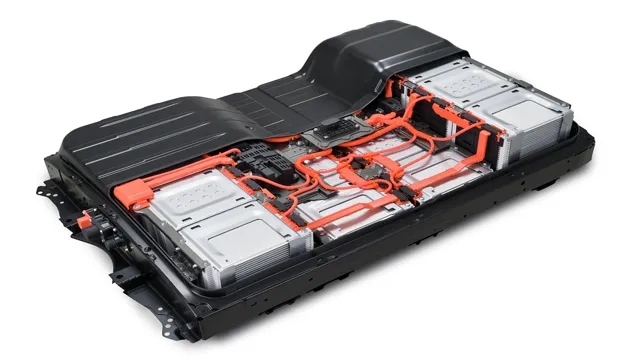The Unseen Impact: Exploring the Carbon Footprint of Electric Car Battery Production
As people become more environmentally conscious, there has been a surge in the popularity of electric cars. These cars are known to be better for the environment as they emit fewer greenhouse gases than traditional gasoline-powered cars. However, when it comes to the manufacturing process of electric car batteries, many people are left wondering about their true carbon footprint.
The truth is that the manufacturing process of electric car batteries does have an impact on the environment. From the mining of minerals to the transportation and assembly of the battery cells, there are several steps involved that produce emissions. But, compared to the environmental footprint of traditional gasoline-powered cars, the impact of electric car batteries is significantly lower.
One analogy used to explain this concept is to think of electric car batteries as a gym membership. Yes, the manufacturing process may produce emissions, but once the battery is installed in the car, it has the potential to power the car for years to come, much like how a gym membership can help improve your health and wellness in the long run. So, while electric car batteries may not be entirely carbon neutral, they are a step in the right direction towards reducing our carbon footprint and creating a more sustainable future.
As technology advances and the manufacturing process becomes more efficient and eco-friendly, the carbon footprint of electric car batteries will continue to decrease.
Overview
When it comes to making an electric car battery, the carbon footprint is a significant concern. The process of manufacturing an electric car battery involves mining and refining metals such as lithium, cobalt, and nickel, as well as plastic, aluminum, and copper. This process is not only energy-intensive but also generates greenhouse gases and other pollutants.
However, the carbon footprint of an electric car battery is still much lower than that of a gasoline-powered vehicle in its lifetime. This is because electric vehicles do not emit tailpipe emissions and are more efficient than gas cars, resulting in lower fuel consumption and carbon emissions. While reducing the carbon footprint of electric vehicle batteries is crucial, it is worth noting that the benefits of driving an electric car significantly outweigh the environmental impact of producing an electric car battery.
Defining Carbon Footprint
Carbon footprint is a term used to describe the total amount of carbon dioxide and other greenhouse gases that an individual, organization, or product generates in its lifetime. In simpler terms, it refers to the environmental impact of our actions, both direct and indirect. This impact can be caused by a range of activities, such as driving a car, using electricity, or purchasing goods and services.
The more someone consumes, the higher their carbon footprint is likely to be. Understanding our carbon footprint and taking steps to reduce it is crucial in mitigating the negative effects of climate change. By making more conscious decisions in our daily lives, such as reducing energy consumption or choosing eco-friendly products, we can all play a part in reducing our overall carbon footprint and protecting the planet for future generations.
Why Electric Car Batteries Matter
Electric car batteries have become a crucial part of the automotive industry due to their ability to power cars without the need for gasoline. The efficiency, reliability, and durability of these batteries are key factors in determining the overall quality of an electric car. Battery technology has rapidly advanced in recent years, with lithium-ion batteries now being the preferred option due to their long life-span, high energy density, and ease of recharging.
With the rise in demand for electric vehicles, batteries will play an even more significant role in the future of transportation. As we search for more environmentally friendly alternatives, electric car batteries have the potential to revolutionize the way we travel.
Data
When it comes to electric cars, one of the key concerns is the carbon footprint associated with their batteries. While electric cars produce relatively low emissions when they are driven, the processes involved in making their batteries can have a significant impact on the environment. One study found that the carbon footprint of producing the battery for an electric vehicle can range from 70 to 190 kilograms of carbon dioxide equivalent per kilowatt-hour of battery capacity.
This is due to the raw materials used in battery production, such as lithium and cobalt, being mined with energy-intensive methods that produce a large amount of carbon emissions. However, efforts are being made to reduce the carbon footprint of electric car batteries. For example, recycling programs are being developed to recover materials from old batteries and new technologies are being developed to improve the efficiency of battery production.
In the meantime, it’s important to weigh the environmental impact of electric car batteries against their potential long-term benefits.
Production Process and Carbon Emissions
As manufacturers, we understand the importance of paying close attention to our production processes and making sure we are minimizing our carbon emissions. One way we do this is by utilizing advanced technology that allows us to accurately measure our carbon footprint and identify areas where we can make improvements. Data is a crucial component in this process, as we need to know exactly how much energy we are using and how much carbon dioxide we are emitting in order to make informed decisions.
By analyzing this data, we are able to make changes to our production processes that reduce our environmental impact and help us work towards a more sustainable future. Ultimately, every little bit counts when it comes to reducing carbon emissions, and we are committed to doing our part to protect the planet.
Comparing Carbon Footprints of Different Battery Types
When it comes to selecting a battery type, one factor to consider is its carbon footprint. Different battery technologies have different levels of impact on the environment. For instance, batteries made from lead-acid emit greenhouse gases during production and disposal, making them less environmentally friendly.
On the other hand, lithium-ion batteries have a far lower carbon footprint and produce less pollution, making them a better choice in terms of green credentials. In addition, battery recycling can significantly reduce the carbon footprint of different battery types, making it an essential aspect to take into account when making a decision. Ultimately, choosing the right battery type depends on a range of factors, including its intended use, environmental impact, and the extent to which it can be recycled.
Impact and Mitigation
The manufacturing process of electric car batteries has a significant impact on the environment, contributing to the carbon footprint of the vehicle. According to research, it takes approximately 10-15 tonnes of CO2 emissions to produce a standard lithium-ion battery. This emission mainly comes from the energy used to mine, process, and manufacture the battery.
However, there are ways to mitigate the carbon footprint of electric car batteries. One way is to use renewable energy sources, such as solar and wind power, to power the battery production process. This way, the emissions from burning fossil fuels can be avoided.
Another way is to recycle the battery materials after their lifespan to reduce the demand for new battery production and to minimize the waste generated from used battery disposal. These measures can help reduce the environmental impact of electric cars, making them a more sustainable solution to reduce carbon emissions and air pollution.
Environmental Impacts of Battery Production
When it comes to the production of batteries, there are a number of environmental impacts that must be considered. Perhaps the most significant issue is the amount of carbon emissions that are generated by the production process. In fact, battery manufacturing has been identified as one of the most carbon-intensive industries in the world.
However, it is important to note that there are many strategies that can be employed to mitigate these impacts. For example, using renewable energy sources to power the production process can greatly reduce carbon emissions. Additionally, designing batteries that are more energy-efficient, and that have a longer lifespan, can also help to reduce the environmental impact of battery production.
By taking a holistic approach, it is possible to minimize the negative impacts of battery production, while still meeting the growing demand for energy storage solutions.
Ways to Reduce Carbon Footprint of Battery Production
Reducing carbon footprint of battery production As the global demand for batteries continues to grow, so does the environmental impact of their production. However, there are ways to reduce the carbon footprint of battery production. One way is by using renewable energy sources such as solar or wind power in the production process.
This not only reduces emissions, but also makes production more sustainable in the long run. Another method is by implementing circular economy principles, which involve recycling and reusing materials to minimize waste. This can include using recycled metals or designing batteries that can be easily disassembled for reuse or recycling.
Additionally, improving the efficiency of production processes can also reduce emissions and energy consumption. While these methods may require upfront investment, they can ultimately lead to cost savings and a more sustainable production process. By taking these steps, the battery industry can work towards reducing its environmental impact and supporting a greener future.
Conclusion
In conclusion, the carbon footprint of creating an electric car battery is complex and multifaceted. From mining the raw materials to manufacturing the battery pack, many steps are involved, each with their own environmental impact. However, the benefits of electric vehicles for reducing greenhouse gas emissions and combating climate change cannot be ignored.
So, while we strive to minimize the carbon footprint of the battery production process, let us also keep our eyes on the prize of a cleaner, more sustainable future. After all, when it comes to carbon footprints, sometimes you have to take a few steps back to make great leaps forward.”
FAQs
What is a carbon footprint?
A carbon footprint is the amount of greenhouse gas emissions produced by a person, organization, or product.
How is the carbon footprint of an electric car battery calculated?
The carbon footprint of an electric car battery is calculated by adding up the emissions produced during the extraction of raw materials, the production process, transportation, and disposal of the battery.
How does the carbon footprint of an electric car battery compare to that of a gasoline car?
The carbon footprint of an electric car battery is generally lower than that of a gasoline car over the entire lifespan of the vehicle, but the process of manufacturing the battery can be more carbon-intensive.
What are some ways to reduce the carbon footprint of electric car batteries?
One way to reduce the carbon footprint of electric car batteries is to use more sustainable materials in their production. Another way is to increase the use of renewable energy sources in the manufacturing process. Recycling and repurposing old batteries can also help reduce their impact on the environment.




